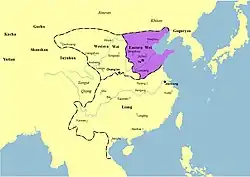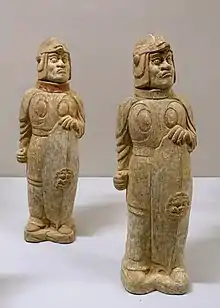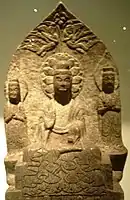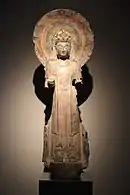Wei 魏 | |||||||||
|---|---|---|---|---|---|---|---|---|---|
| 534–550 | |||||||||
 Eastern Wei and neighbors | |||||||||
| Capital | Luoyang (534) Yecheng (534–550) | ||||||||
| Government | Monarchy | ||||||||
| Emperor | |||||||||
• 534–550 | Emperor Xiaojing of Eastern Wei | ||||||||
| History | |||||||||
• Established | 8 November[1] 534 | ||||||||
• Disestablished | 7 June[2] 550 | ||||||||
| Currency | Chinese coin, Chinese cash | ||||||||
| |||||||||
| Today part of | China | ||||||||
| Part of a series on the |
| History of China |
|---|
Wei (/weɪ/), known in historiography as the Eastern Wei (simplified Chinese: 东魏; traditional Chinese: 東魏; pinyin: Dōng Wèi), was an imperial dynasty of China that followed the disintegration of the Northern Wei dynasty. One of the Northern dynasties during the Northern and Southern dynasties period, the Eastern Wei ruled the eastern part of northern China from 534 to 550. As with the Northern Wei, the ruling family of the Eastern Wei were members of the Tuoba clan of the Xianbei.
History
Gao Huan was the potentate of the eastern half of what was Northern Wei territory. In 534, following the disintegration of the Northern Wei dynasty, he installed Yuan Shanjian as ruler of Eastern Wei. Yuan Shanjian was a descendant of the Northern Wei. Yuan Shanjian was a puppet ruler, as the real power lay in the hands of Gao Huan. Several military campaigns, such as the Battle of Shayuan, were launched against the neighboring Western Wei in an attempt to reunify the territory once held by the Northern Wei, however these campaigns were not successful. In 547 Gao Huan died. His sons Gao Cheng and Gao Yang were able to pursue his policy of controlling the emperor, but in 550 Gao Yang deposed Yuan Shanjian and founded his own dynasty, the Northern Qi.
Art
The Buddhist art of the Eastern Wei displays a combination of Greco-Buddhist influences from Gandhara and Central Asia (representations of flying figures holding wreaths, Greek-style folds of the drapery), together with Chinese artistic influences.
 Armored warriors, China, Eastern Wei dynasty, 534-550 AD
Armored warriors, China, Eastern Wei dynasty, 534-550 AD
.jpg.webp) Eastern Wei Buddhist triad
Eastern Wei Buddhist triad Eastern Wei Limestone Bodhisattva.
Eastern Wei Limestone Bodhisattva.
References
Citations
- ↑ Zizhi Tongjian, vol. 156.
- ↑ Zizhi Tongjian, vol. 163.